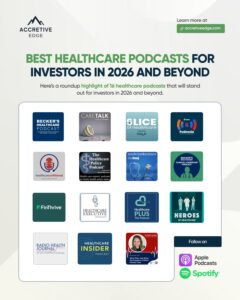Skip to the healthcare Chief Operating Officer job description template below, or read on for more context.
Healthcare COOs in 2025 face a tougher mix of challenges than ever: thin margins, staffing shortages, fast-moving tech adoption, and rising compliance demands.
The role has shifted from running daily operations to balancing strategy, execution, and culture — often across multi-site systems.
Looking at active COO job descriptions gives us a clear view of what’s expected — and how the role is evolving. Here’s what’s changing, what’s consistent, and what to expect next.
Core Responsibilities of Healthcare COOs
Across postings, the same clusters of responsibility appear consistently. Wording varies, but the scope and expectations are strikingly similar.
1. Operational Oversight
COOs retain direct responsibility for clinical and non-clinical operations, but the scale is broader. Many postings specify oversight of multiple hospitals, ambulatory care centers, specialty clinics, or behavioral health programs.
Service-line leadership is common, with mentions of surgical services, emergency departments, and outpatient facilities. The focus is on consistent, high-quality care delivery, supported by efficient supply chain management, facilities operations, and support services.
2. Financial Stewardship
Nearly every posting pairs operational leadership with direct P&L accountability. This often includes budgeting, forecasting, and capital project oversight, as well as leading revenue cycle functions.
Several roles call out cost-containment initiatives tied to productivity benchmarks, and a few specify responsibility for aligning budgets with value-based care reimbursement models.
3. Quality and Safety Leadership
Partnering with chief medical and nursing leaders to maintain or improve quality scores is now standard. COOs are expected to lead patient safety programs, meet or exceed regulatory requirements (CMS, Joint Commission), and oversee performance improvement initiatives. In some postings, this extends to responsibility for health equity goals and patient experience targets.
4. Workforce Management
Workforce leadership goes beyond staffing ratios. Postings highlight recruitment, retention, and engagement strategies for both clinical and administrative staff. A recurring theme is addressing turnover through culture-building and professional development programs.
5. Strategic Execution
The COO is positioned as a primary driver of enterprise initiatives: EHR upgrades, service-line expansions, facility openings, mergers and acquisitions, and integration of newly acquired sites.
Technology enablement is increasingly part of this brief, with postings referencing digital health implementation, telehealth expansion, and operational analytics. A few explicitly tie this work to readiness for value-based care contracts and alternative payment models.
Qualifications and Skills in Demand for Healthcare COOs
Education and Credentials
Most postings require a master’s degree in healthcare administration, business administration, or a related field. A smaller but notable number specify clinical credentials (MD, RN, or other licensure) as “preferred,” especially for systems with a strong clinical integration agenda.
Experience Thresholds
The baseline is substantial: typically 10–15 years in healthcare leadership, with at least five in a senior operations role. Multi-site experience is increasingly non-negotiable, as is a track record of managing large, complex budgets. Many postings prefer prior success with both acute and ambulatory operations.
Technical and Operational Competencies
- Deep understanding of hospital and clinic operations
- P&L management and capital project oversight
- Knowledge of healthcare reimbursement, including value-based care models
- Familiarity with EHR systems (Epic, Cerner) and digital health tools
- Process improvement methodologies
Leadership and Change Skills
The soft skills required are anything but: strategic thinking, change management, cross-functional collaboration, and the ability to influence at all levels. Several postings explicitly mention “transformational leadership” — the capacity to lead significant change without destabilizing operations.
Cultural and Market Awareness
An emerging trend is the call for leaders who understand the dynamics of health equity, community engagement, and workforce diversity. This is often paired with experience navigating competitive healthcare markets and building external partnerships.
The pattern is clear: employers want COOs who combine operational mastery with strategic agility — equally comfortable stabilizing a budget, leading a merger, or walking the floor to troubleshoot bottlenecks in patient flow.
Salary Ranges and Incentives for Healthcare COOs
Pay for healthcare COOs in 2025 spans a wide range, shaped by organization size, scope, and market. National data and recent job postings show a clear split between mid-six-figure salaries for many healthcare operations leaders and much higher packages for COOs in large hospital systems.
Across settings, ZipRecruiter reports an average annual salary of about $151,000, with most between $111,500 and $185,000. Top earners approach $233,000.
In large hospitals and health systems, compensation climbs sharply. ERI SalaryExpert puts the average base for a hospital COO at $336,000 plus about $133,000 in bonuses — total pay near $470,000. Some recent postings go higher: UCHealth Medical Group listed $346,028–$519,022, UCSF Health advertised $273,200–$575,400, and Swedish Health Services noted base pay with additional incentive eligibility.
Incentives are common. Many tie bonuses to operational performance, patient satisfaction, and financial results. Benefits packages almost always include retirement plan matches (401k or 403b), comprehensive health coverage, generous PTO, and often relocation support. Some employers add stock purchase plans, tuition reimbursement, or loan forgiveness programs.
Performance Metrics and Success Measures for Healthcare COOs
While not every posting lists formal performance targets, many give clear signals about how success will be measured for the COO role. The measures tend to balance operational stability with strategic progress.
Operational Performance
- Meeting or exceeding quality scores (CMS Star Ratings and Joint Commission compliance)
- Maintaining or improving patient safety metrics (e.g., hospital-acquired infection rates, readmission rates)
- Achieving productivity and efficiency benchmarks in both clinical and non-clinical areas
Financial Outcomes
- Hitting margin targets and staying within budget
- Delivering cost-reduction initiatives without harming quality or access
- Improving revenue cycle performance (days in A/R, denial rates)
Strategic Execution
- On-time, on-budget completion of major projects (EHR upgrades, facility openings, service-line launches)
- Successful integration of acquired facilities or new programs
- Advancement of value-based care readiness, including participation in shared savings or alternative payment models
Workforce Health
- Staff turnover and vacancy rates
- Employee engagement scores
- Progress on diversity, equity, and inclusion (DEI) goals
Market and Community Impact
- Growth in market share or patient volumes in targeted service areas
- Strengthened relationships with community partners and referring providers
Emerging Trends Shaping the COO Role
1. Expanded Scope Beyond Hospital Walls
Many COOs now oversee ambulatory networks, post-acute care, home health, and even payer-provider joint ventures. The role is increasingly system-wide, with less focus on a single flagship hospital.
2. Technology as a Core Operational Lever
Mentions of EHR optimization, telehealth expansion, and digital health adoption are more frequent than in past years. COOs are expected to use operational data analytics to drive decision-making, not just to report performance.
3. Direct Involvement in Value-Based Care Readiness
Some postings place the COO alongside the CFO and CMO in preparing for risk-based contracts. That includes aligning operations to quality measures, cost benchmarks, and care coordination requirements.
4. Workforce Stabilization as a Strategic Priority
Staffing shortages have moved from an HR problem to a C-suite agenda. COOs are being asked to lead retention programs, labor negotiations, and workforce pipeline initiatives in partnership with HR and nursing leadership.
5. Greater Emphasis on Community and Equity Goals
A subset of postings now call out health equity explicitly, tying operational leadership to closing gaps in access, outcomes, and patient experience across diverse populations.
The shift is clear: the COO role is no longer about simply “keeping the trains running.” It’s about orchestrating complex, system-wide change while managing today’s operational realities — a dual mandate that demands both breadth and precision.
COOs Who Balance Operations and Strategy Will Win
The healthcare COO role in 2025 is bigger, faster-moving, and more strategically critical than ever. The postings we reviewed show leaders being hired not just to run operations, but to transform them — integrating new service lines, modernizing technology, preparing for value-based care, and stabilizing a strained workforce.
It’s a balancing act: protect today’s margins while building the capabilities for tomorrow’s reimbursement models. For candidates, that means showing you can think like a strategist, act like an operator, and lead through constant change. For organizations, it means finding leaders who can bridge the gap between day-to-day delivery and long-term positioning.
Healthcare Chief Operating Officer: Job Description Template
The following job description template was drafted for hospital chief operating officers. Tweak it as needed.
Position Summary
The hospital chief operating officer (COO) is a key member of the executive leadership team, responsible for overseeing daily hospital operations, ensuring high-quality patient care, and aligning operational performance with strategic goals. Reporting directly to the chief executive officer (CEO), the COO provides leadership across clinical, administrative, and support departments, balancing day-to-day efficiency with long-term growth, financial stability, and regulatory compliance.
Key Responsibilities
Strategic Leadership
- Partner with the CEO and senior leadership team to develop, communicate, and execute the hospital’s strategic plan.
- Translate strategic goals into actionable operational initiatives with measurable outcomes.
- Serve as acting CEO in their absence, representing the hospital in internal and external forums.
- Build collaborative relationships with physician leaders, nursing leadership, and department heads to ensure alignment on patient care priorities.
Operational Oversight
- Direct and coordinate the activities of assigned hospital departments and service lines, ensuring quality, safety, and efficiency.
- Oversee facility operations, including capital projects, renovations, and equipment acquisition.
- Implement systems, processes, and performance metrics to optimize patient flow, reduce wait times, and enhance the patient experience.
- Drive service-line development and integration, including acute, ambulatory, and specialty care programs.
Financial Stewardship
- Maintain P&L accountability for assigned areas; lead budgeting, forecasting, and cost-control initiatives.
- Monitor and improve financial performance, including revenue cycle management, productivity benchmarks, and resource utilization.
- Align financial plans with value-based care models and evolving reimbursement strategies.
Quality, Safety, and Compliance
- Partner with clinical leaders to meet or exceed quality benchmarks, patient safety goals, and accreditation requirements (CMS, Joint Commission, and other regulatory bodies).
- Oversee compliance with all applicable federal, state, and local regulations.
- Lead continuous quality improvement initiatives that advance health equity, patient satisfaction, and community impact.
Workforce and Culture
- Recruit, develop, and retain top talent across clinical and administrative teams.
- Foster a culture of accountability, collaboration, and professional development.
- Champion diversity, equity, and inclusion goals across the workforce.
Community and Market Engagement
- Represent the hospital with community partners, government agencies, and industry organizations.
- Develop partnerships to expand access to care and strengthen the hospital’s market position.
Qualifications
Education
- Master’s degree or higher in healthcare administration, business administration, or a related field required.
- Clinical background (MD, RN, or other licensure) preferred in systems with strong clinical integration goals.
Experience
- 10+ years of progressive leadership experience in hospital or healthcare operations, including at least 5 years in a senior executive role.
- Proven track record in managing multi-department or multi-site operations within an acute care environment.
- Demonstrated success with P&L management, strategic project execution, and operational improvement.
Skills and Competencies
- Strong strategic thinking and decision-making skills.
- Expertise in hospital operations, financial management, and regulatory compliance.
- Ability to build consensus across diverse stakeholder groups.
- Excellent communication, negotiation, and change management skills.
- Familiarity with EHR systems, digital health tools, and operational analytics.
Working Conditions
- Full-time, on-site leadership role with some evening, weekend, and on-call responsibilities.
- May require occasional travel between hospital campuses or to off-site meetings.
Compensation and Benefits
Base salary range: $325,000–$475,000 annually, plus performance-based incentive eligibility.
Comprehensive benefits package includes:
- Medical, dental, and vision coverage for employees and eligible dependents
- Retirement plan with employer match (401k, 403b, or pension)
- Paid time off, paid holidays, and other leave programs
- Relocation assistance, if applicable
- Continuing education, tuition reimbursement, or student loan repayment
- Life, disability, and supplemental insurance options
- Employee wellness programs and other organizational perks
About [Hospital Name]
[Hospital Name] is a leading [number]-bed acute care facility serving [region]. With nationally recognized programs in [key specialties], a commitment to clinical excellence, and deep ties to the community, we provide high-quality, compassionate care to patients and families. Our mission is to improve health and well-being through exceptional patient care, innovation, and community partnership.






